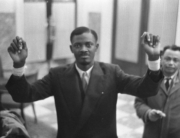Without saying why, Jono McLeod’s documentary My Old School introduces viewers to Brandon Lee, a student who enrolled at a prestigious Scottish high school in 1993, first through news footage that vaguely references a scandal and then via talking-head accounts from former classmates. Details are doled out slowly. Was he a serial killer? Did he market the 1993 Glasgow equivalent of the Fyre Festival debacle? Classmates refer to him with his full name, “Brandon Lee,” which is always an intriguing sign.
McLeod was one of Brandon’s former schoolmates from that time, so he knows where the story goes but keeps that secret from viewers. What made Brandon famous is shared sparingly, building a central mystery that’s easy to guess at but not confirmed until halfway through the running time. Along with playful animated reenactments of Brandon’s school days in the style of early ’90s MTV cartoons like Daria, McLeod creates a moment in time at Bearsden Academy, the Glasgow high school where Brandon made headlines. So much time is spent inhabiting this world, and so many details are kept from viewers to create suspense, that there isn’t enough room for analyzing why Brandon did what he did (or explore its ramifications) to make the documentary feel more than an odd footnote.
His classmates knew he was different on his first day of school. His face looked as though he had plastic surgery, and he seemed older, more intelligent than his peers. He had a taste in music no one else at school had (which helps create a period-specific soundtrack with post-punk and pop bands like Television, Pulp, Orange Juice). He had an outlandish personal history involving living in a Canada, a car crash, and many dead relatives. Even his name is dramatic: Brandon is the first name of a Beverly Hills 90210 hunky protagonist, and he shares the full name of star Bruce Lee’s son, who died shooting The Crow just months before Brandon joined the school. Maybe you can already guess the scandal, if you didn’t know already.
Brandon was interviewed extensively for the documentary but stipulated that only the audio of his voice could be used, and not visuals of what he looks like today. So, Alan Cumming reenacts Brandon’s contemporary interviews. (The actor was going to star in and direct a film about Brandon back in the ’90s.) It’s one more element that makes the mystery more mysterious: Why won’t Brandon show his face?
McLeod never explains that, and that’s part of the problem of the film’s last third, where some things are explained and others left unexplored. There is no narrator, no one to help sort through the details, just interviews. McLeod uses Brandon’s former classmates to speculate what really happened, filming a few of them as they inform each other of facts and rumors, and leaves the psychological guesswork to their responses. When the director’s peers question each other about Brandon’s motives, there’s something fascinating in that line of inquiry, but any analysis or explanation they offer feels unfocused and unverified, almost like reading comments in a news article.
For his part, Cumming’s performance is understated, physically embodying a furtive figure who clearly still has secrets and wounds, even when recounting his past with pride. (It’s also strange hearing Cumming without his famously distinctive voice.) The animation and music are satisfyingly period specific, but it’s the slow release of information and what’s later analyzed that feels lacking.







Leave A Comment